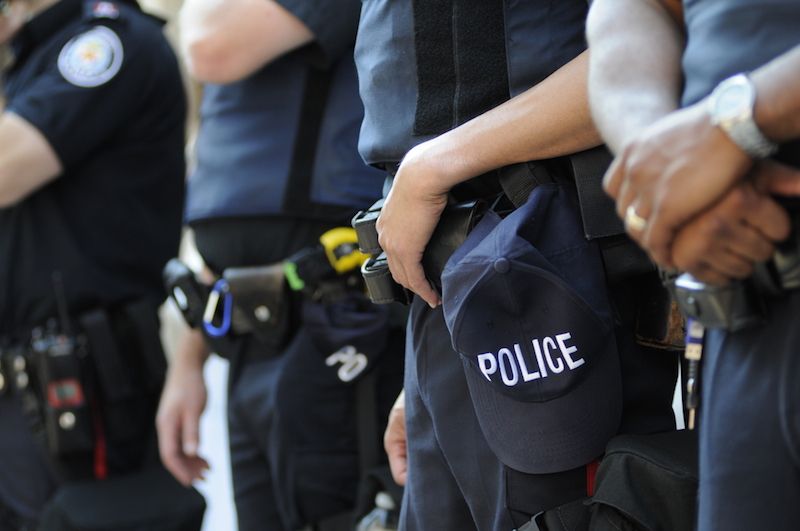Police Killings and Race: Do the Numbers Tell the Whole Story?

Police officers in the U.S. are more likely to stop or arrest black, Hispanic and Native American people than they are to stop or arrest non-Hispanic white people, a new study finds.
The researchers also found that more blacks, Hispanics and Native Americans were killed and injured by police over the study period than non-Hispanic whites.
"Both blacks and white Hispanics are four times as likely to be killed by the police as white non-Hispanics are," said lead study author Ted Miller, a senior research scientist at the Pacific Institute for Research and Evaluation in Maryland. "Native Americans are six times as likely to be killed by the police as whites." [How to Talk About Race to Kids: Experts' Advice for Parents]
Live Science reached out to the National Association of Police Organizations (NAPO) for a comment on the new findings, but NAPO's representatives did not provide a comment by press time.
The new study "is only the second study to analyze health data on nonfatal injuries caused by police, and the first to do so using a national U.S. data set," said Justin Feldman, a graduate student at the Harvard T.H. Chan School of Public Health, whose research focuses on using data about injuries and fatalities to monitor police violence.
"This in itself is a welcome development," said Feldman, who was not involved in the new study. However, Feldman and other experts who were not involved in the study pointed out that there were certain limitations concerning some of the study's findings.
In the study, the researchers looked at injuries and deaths that resulted from legal police interventions in the U.S. during 2012. Those interventions included arrests, stop-and-search incidents that occurred on the street, and traffic stops that involved a search.
Sign up for the Live Science daily newsletter now
Get the world’s most fascinating discoveries delivered straight to your inbox.
To conduct their study, the researchers analyzed national data from several sources: the 2012 Vital Statistics Mortality Census, the 2012 Healthcare Cost and Utilization Project, nationwide inpatient and emergency department samples, two newspaper censuses of police-related deaths, FBI reports for arrests and the 2011 Police-Public Contact Survey.
The researchers found that, during 2012, there were 12.3 million arrests, 2.8 million street stop-and-search incidents and 1 million traffic stops involving searches. Police officers were more likely to stop or arrest black, Hispanic and Native American people than they were to stop or arrest non-Hispanic white people. The rate of stops and arrests was about 500 per 10,000 people for non-Hispanic whites. In comparison, the rates were 1,400 per 10,000 people for blacks; 1,000 per 10,000 people for Hispanics; and 1,140 per 10,000 people for Native Americans, Miller said.
But to find out how often such incidents resulted in a death, the researchers turned to two news publications (The Washington Post and The Guardian), which have compiled statistics on such deaths by searching for news reports about these incidents. That's because previous research on federal databases shows that these databases tend to undercount deaths from police interventions, and other previous research has suggested that the news publications' reporting is reliable, the researchers said.
The researchers estimated that during police interventions in 2012, the police killed a total of 1,000 people in the U.S. and injured another 54,300 people, who required hospital treatment for their injuries.
When the researchers looked at how people died during police interventions, they found that almost all (95 percent) were killed with firearms. The remaining 5 percent of the deaths involved the use of tasers, the researchers found.
Most of the people in the study with nonfatal injuries were harmed by blows or by being hit with blunt objects, the researchers found. Less commonly, a police officer's use of tear gas, mace or pepper spray led to someone being hospitalized, the researchers said in their study, published July 25 in the journal Injury Prevention.
Together, those findings meant that 1 in 291 stops or arrests led to the injury or death of a suspect or bystander, the researchers said. [Fight, Fight, Fight: The History of Human Aggression]
When the researchers looked at the number of people who were killed or injured as a result of police interventions per 10,000 stops and arrests — that is, the rate at which these incidents occurred — they found that the rates did not vary by the ethnicity of the people involved. In other words, black, Hispanic, Native American and non-Hispanic white people who were stopped or arrested were all equally likely to be killed or injured as a result of these interventions.
"Consistent with our findings, simulation studies find police are no more likely to fire on unarmed blacks than unarmed whites, and high rates of black speeding citations per capita result from high violation rates," the authors wrote in the study.
However, the numbers of black, Hispanic and Native American people who were killed or injured during interventions during the study period were still higher than the number of non-Hispanic white people killed or injured, because black, Hispanic and Native American people were stopped and arrested much more frequently than white people, Miller said.
Limitations and racial bias
Feldman and other outside experts noted that the study had certain limitations.
For example, Feldman said, "The authors conclude that black people who are arrested are no more likely to be injured or killed than white people who are arrested," he said. "They interpret this as evidence that there is no racial bias in use of force."
However, Feldman said, the researchers did not take into account important differences between the populations of black people who typically get arrested and the white people who typically get arrested.
"Black people are much more likely to be arrested for nonviolent, low-level offenses such as drug possession or public transit fare evasion," and in police interventions for such nonviolent offenses, the use of force by the police is largely preventable, he said.
Conversely, white people are much less likely to be scrutinized by the police for low-level offenses than black people, "so, while [white people] are arrested at lower rates, the average white arrestee is more likely to stand accused of a violent crime," Feldman said.
"Comparing these two populations of arrestees is akin to comparing apples and oranges, and doing so will inevitably underestimate racial bias," he said.
Moreover, the authors cherry-picked examples from scientific literature to support some of their statements, said Hannah Cooper, an associate professor of behavioral sciences and health education at Emory University who was not involved in the study. [Understanding the 10 Most Destructive Human Behaviors]
For instance, the authors cited some research suggesting that black people are stopped for traffic infractions in a way that is proportionate to their violations of traffic laws, Cooper said. "That's just not true," she said. "There is a lot of literature on the fact that officers disproportionately target black men, in particular, when [black men] are driving and stop them for having a broken taillight or things that they don't stop white drivers for."
Dr. Mindy Thompson Fullilove, a professor of clinical sociomedical sciences and psychiatry at Columbia University who was not involved in the study, said the authors didn't provide an adequate discussion of some of the findings presented in the study. For example, the authors did not discuss why black, Hispanic or Native American people are stopped and arrested more often than white people in the first place.
This lack of discussion "sidesteps the racism that is involved in the excess rate of stops and arrests," of people of color, she said. For example, policies such as Stop and Frisk have been known to target young people of color, but the authors didn't discuss that, she said.
Originally published on Live Science.



